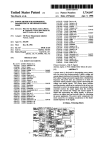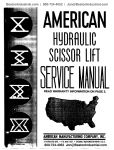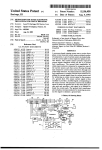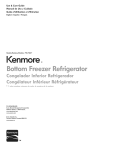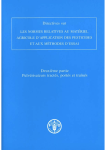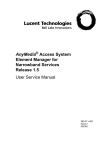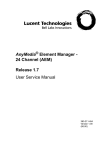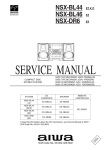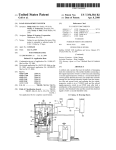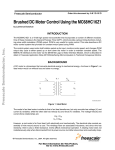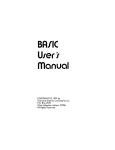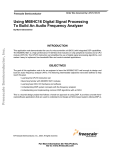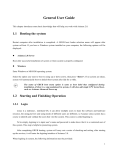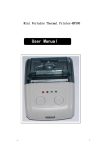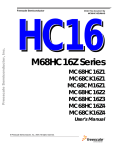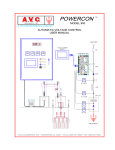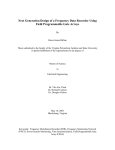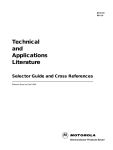Download ANZ XTAL:lj12
Transcript
US006370483B1 (12) United States Patent (10) Patent N0.: Beckwith (54) (76) (*) US 6,370,483 B1 (45) Date of Patent: *Apr. 9, 2002 SYNCHRONOUS LINEAR MACHINE FOR 4,871,971 A * PROTECTIVE RELAYING 5,315,527 A * 5/1994 Beckwith . . . . . . . . . . . . .. 5,544,064 A * 8/1996 Beckwith . . . . . . . . .. 700/293 Robert W. Beckwith, 2794 Camden 57646512 A * 7/1997 Beckwlth ~ ~ ~ ~ ~ ~ ~ ~ " 323/257 Rd‘, Clearwater, FL (Us) 337594007 5,774,366 A * Inventor: Notice: Subject to any disclaimer, the term of this 10/1989 Jeerings et a1. ............. .. 361/47 6/1998 Beckwith ................... .. 702/64 OTHER PUBLICATIONS patent is extended or adjusted under 35 _ U_S_C_ 154(k)) by 0 days_ Phadke & Thorp, Computer Relaymg for PoWer Systems Thi_5 Pawnt is Subject to a terminal disClalmer- John Wiley and Sons, NeW York, 1988 pp. 123—129.* Altuve, DiaZ, and Vasquez, Fourier and Walsh Digital Fil tering Algorithms for Distance Protection, IEEE Transac tions on PoWer, vol. 11, No. 1, Feb. 1996, pp. 457—462.* (21) Appl' NO‘: 09/303’449 (22) Filed; 702/72 HarloW, J.H., A Multifunction Protective Relay for the May 3, 1999 Cogeneration Industry, IEEE Computer Application in PoWer, vol. 3, No. 4, 1990, pp. 25—30.* Yalla, Murty V.V.S., A Digital Multifunctional Protective Relay, IEEE Transactions on PoWer Delivery, vol. 7, No. 1, Related US‘ Application Data (60) lgg‘gsional application NO‘ 60/089271’ ?led on Jun‘ 15’ ' 1992, pp. 193—201.* (51) Int. Cl.7 ...................... .. G01R 19/00; G01R 25/00; (52) US. Cl. ........................... .. 702/65; 702/64; 702/72; (58) _ ’ Field of Search ............................. .. 702/64—66, 71, HOZH 3/00 * cited by examiner 361/35' 361/79 . 702/72, 73, 70_74; 361/35, 47, 65, 79; 327/2, 3, 15, 141, 101, 104; 700/286, 292—294; . (74) Attorney, Agent, or Ftrm—Leo J. Aubel (57) ABSTRACT 323/207, 211 (56) . Primary Exammer—Bryan Bui - Synchronous programs give increased sampling rates of AC References Cited signals and provide AC phasors yielding fast response to undesired conditions. U.S. PATENT DOCUMENTS 4,256,972 A * 3/1981 Wyatt et al. ................ .. 307/68 19 Claims, 6 Drawing Sheets +5VDC 1 TpMPmn VRH VDD F|g.3B F1 ANO DATA TO MP100 — F2 .35 4 AN1 F3 XTAL:lj12 ANZ EXTAL F4 ANS CLK — OUT TOMP10O PCO Fig.3B P01 Optional To MP200 F5 AN4 , P02 '5 I N |C Pea +9100 F11— F6 ‘ ANS . — PC4 '6 N I Ma") N — P05 VRL vss U.S. Patent Apr. 9, 2002 Sheet 1 0f 6 US 6,370,483 B1 FIG. 1 90° Power Flow + 180° 270° + - Var Flow FIG. 2 U.S. Patent Apr. 9, 2002 Sheet 3 0f 6 US 6,370,483 B1 See FIg 4A LCI VDD 100 /\/ From MC1<—- DATA Optional R | D' eg‘jwe'r've From MC1——- CLOCK IN 10!. , I . To Re,'ayl g“ r- CIRCUIT Drivel 1- BREAKER N BINARY * D100 OUTPUTS _|_éfl/ ~ BINARY p51 l —— I N ‘ /// LEDs D101 N' INPUT _|_ N 1 2 /~ 0 DATA VSS Isolated RS232 PORT U.S. Patent 85+ Apr. 9, 2002 _ Sheet 5 0f 6 US 6,370,483 B1 8> 1% ww> $2 . .2»?Fz<. .m 2% .QEm swk NEW VI E8 2a W21 mom Nol-A E To 2‘ :m8 mm8841>‘ U.S. Patent Apr. 9, 2002 $116666 6 6f 6 US 6,370,483 B1 #56 r mw> 1% $2. NEW §\ vE Eme 20 0 >?I W21 82i - Fz<6 EM 88é> No -m E Q5 ANS 2 8 US 6,370,483 B1 1 2 SYNCHRONOUS LINEAR MACHINE FOR PROTECTIVE RELAYING completed While the phase angle betWeen the tWo sources is Within a selected phase angle WindoW. The second criterion This application claims the priority date of provisional patent application Ser. No. 60/089,271 ?led on Jun. 15, 1998. BACKGROUND OF THE INVENTION It is the present practice of a BeckWith Electric Company line of generator and transformer protective relays to sample alternating current (AC) voltage and current Waves some small number of times, such as 16 per cycle, and then use 10 operation does protect equipment from damage. In addition, Fourier transforms to compute phasor quantities represent ing fundamental components of the Waves. Reference is made to the folloWing book and articles on the present related state of the art: as in protective relays that detect fault conditions, its opera tion likeWise depends on a cycle by cycle measurement of 15 voltage and current Waves. In making improvements over the present art, use is made [1] Phadke, A. G. and J. S. Thorp, Computer Relaying for PoWer Systems, John Wiley and Sons, NeW York, 1988, pp. 123—129. [2] Hector J ., Altuve F., Ismael DiaZ V. and Ernesto ?rst separates the motors from the ?rst source and then makes a synchronous transfer When the isolated motor bus falls behind the second source by 360 degrees. The third criterion of transfer is used if the motor bus voltage falls beloW a selected value before the 360 degree point is reached. While a bus transfer device does not have the requirement to trip a circuit breaker in order to interrupt a fault current, it is classi?ed herein as a protective device since proper herein of the folloWing inventions, all by the present inventor, Robert W. BeckWith. A) US. Pat. No. 5,315,527, METHOD AND APPARA 20 TUS PROVIDING HALF-CYCLE DIGITIZATION OF AC SIGNALS BY AN ANALOG-TO-DIGITAL VaZqueZ M., “Fourier and Walsh digital ?ltering algo rithms for distance protection”, IEEE Transactions on CONVERTER, describes apparatus and methods for PoWer, vol. 11, No. 1, February 1996, pp. 457—462. [3] HarloW, J. H., “A multifunction protective relay for the cogeneration industry”, IEEE Computer Application in PoWer, vol.3, No.4, 1990, pp.25—30. sensing positive half cycles of AC signals. 25 B) US. Pat. No. 5,544,064, APPARATUS AND METHOD FOR SAMPLING SIGNALS SYNCHRO NOUS WITH ANALOG-TO-DIGITAL CONVERTER, describes apparatus and methods use [4] Yalla, Murty V. V. S., “A digital multifunction pro tective relay”, IEEE Transactions on PoWer Delivery, ful for obtaining digital samples of AC Waves synchro vol.7, No.1, 1992, pp.193—201. Making use of inventions as found in US. Pat. No. nous With free running analog to digital converters 30 5,224,011, MULTIFUNCTION PROTECTIVE RELAY, one typical product, model M-4320 manufactured by the BeckWith Electric Company, uses a digital signal processor (DSP) running at some 80 megabits per second, to compute (ADCs). C) US. Pat. No. 5,774,366, AMETHOD FOR OBTAIN ING THE FUNDAMENTAL AND ODD HARMONIC Fourier transforms of the Waves as digital samples are taken. 35 The results are fed to a dual ported random access memory Where they are available to a host processor. The host COMPONENTS OF AC SIGNALS, describes methods for obtaining the fundamental component and odd harmonics of half Wave AC signals. D) US. patent application Ser. No. 710,816, TWO WAY PACKET RADIO INCLUDING SMART DATA BUFFER AND PACKET RATE CONVERSION, the inventer herein, ?led on Sep. 23, 1996 describes appa processor, operating at 10 megabits per second, uses the results to compute the existence of electrical fault conditions and to output commands for tripping circuit breakers so as to quickly remove electric poWer feeding faults. In the M-4320 it is necessary to use analog component anti-aliasing ?lters to prevent errors due to problems intro duced by the use of a small number of digital samples of the 40 ratus and methods of communicating synchronously With the poWer frequency as useful in the present invention. The present invention combines use of the half Wave AC Wave. Since the electronic circuit is connected to earth 45 technology of US. Pat. No. 5,315,527 together With the synchronous linear technology of US. Pat. No. 5,544,064 and methods for obtaining the fundamental component and ground, transformers must be used for all current and voltage inputs. odd harmonics of a half Wave AC signal of US. Pat. No. Another BeckWith Electric Company product line makes 5,774,366 in reducing the hardWare and softWare require use of inventions contained in US. Pat. No. 4,310,771 METHODS FOR TRANSFERRING POWER IN A SYN CHRONOUS MODE TO A MOTOR BUS, US. Pat. No. 4,256,972 POWER TRANSFER RELAY and US. Pat. No. 4,311,919 TRANSFER LOGIC CONTROL CIRCUITRY In products based on the above referenced US. Pat. Nos. 4,310,771, 4,256,972 and 4,311,919 a ?rst analog device is ments While at the same time increasing the operating speed of devices useful in AC electric poWer apparatus. Means of communicating betWeen devices using the present invention and any of the many protocols in use at the time of Writing of this application are provided by the inventive means and 55 methods by reference US. patent application Ser. No. 710, used to develop information useable for the transfer of a 816. motor bus from a ?rst source to a second source, not US. Pat. No’s. 5,315,527, 5,544,064, 5,774,366 and US. patent application Ser. No. 710,816 are incorporated herein necessarily in phase With the ?rst, in a sequence of criteria. A second combined analog and digital device uses the by reference. information to effect the transfer. Use of these devices SUMMARY OF THE INVENTION results in a large and expensive combination of equipment. The transfer of motor busses is sometimes made manually This invention utiliZes tables of sine and cosine functions multiplied by digital samples of AC Waves to obtain, by for operating reasons. At other times the transfer may be initiated automatically due to the failure of a bus presently in use. The ?rst criterion used is called the “fast transfer” and operates if calculations indicate that the transfer can be 65 cross correlation, the values of phasors for the Waves, thus eliminating the need for Fourier transform calculations required in many prior art devices. These phasors are obtained one or more times per cycle of AC voltage and US 6,370,483 B1 3 4 current Waves in order to determine output requirements, ADC input, a squared Wave, F in FIG. 2, is created at MC1 binary inputs F1 through F6 of FIG. 3a. The square Wave generally in the form of operation of solid state sWitches. In a ?rst microprocessor, linear programs, using ?xed identi?es positive and negative half cycles of the recti?ed operating time loops, operate synchronously With micropro AC Waves. cessor ADCs. These ADCs produce digital samples in matching loops and require no ongoing instructions from the linear programs. A second microprocessor obtains the pha contained in US. Pat. No. 5,544,064 referenced above. Floating point arithmetic is not used. These programs run sor information via a high speed synchronous data bus from the ?rst microprocessor and computes results such as fault clearing and motor bus transfer conditions. Use of linear Programs are used in MC1 based on the inventions continuously using no interrupts. By adding do-nothing steps in program loops Written in assembly language, the 10 the result register of MC1. This provides the highest possible digital sampling rate along With the longest possible com putation time betWeen digital samples using any selected programs loops matching those of the ?rst microprocessor avoids data clashes betWeen the tWo microprocessors. Both microprocessor programs run continuously Without the use of interrupts. Functions of the tWo microprocessors are combined into 15 MC. The process is illustrated using a Motorola 20 MC68HC16Z1 microcontroller (a microprocessor having an ADC). In reference to the Motorola M68HC16 Family User’s Manual MC68HC16Z1UM/AD, Which is incorpo rated herein by reference, one ?nds: (The page references beloW are in the aforesaid Manual.) a) The maximum system clock for the MC68HC16Z1 is 16.78 MHZ. Either a crystal (nominal frequency: 32.768 kHZ) or an externally generated signal can be used. (Page one microprocessor for protection of single phase equipment and for motor bus transfer. Examples are given for use of the invention. BRIEF DESCRIPTIONS OF THE DRAWINGS FIG. 1 shoWs relations betWeen four quadrants of phasors. FIG. 2 shoWs combination of monopolar ADC inputs With logic inputs to determine four quadrant phasors. FIGS. 3a and 3b illustrates a basic circuit for three phase loop is completed just in time to ?nd a neW ADC result in 25 protective relays having three voltage and three current 1—1). b) The analog-to-digital converter module (ADC) is a unipolar, successive-approximation converter With eight inputs. modes of operation. It has selectable 8- or 10- bit resolution. FIG. 4 illustrates a circuit With three voltage inputs useful for motor bus transfer applications. (8- is used in the illustration contained herein). (Page 6.1). 30 FIG. 5 shoWs single phase inventive protective relay circuitry using “smart” three terminal fuses to interrupt currents. MC68HC16Z1UM/AD.) FIG. 6 shoWs single phase inventive protective relay circuits using small ground currents to cause ground fault circuit breakers to interrupt currents. The system clock must be divided by an integer number of at least 8 to obtain an ADC clock frequency of 2,097,500 cycles per second. (Rounded off to 2.1 MHZ on page 6—14 and elseWhere of said referenced manual 35 c) As seen on page 6—15 of the referenced manual, an ADC resolution of 8 bits is obtainable using 16 ADC clock cycles conversion time per sample. DETAILED DESCRIPTION OF THE PREFERRED EMBODIMENTS The invention is described hereinunder using presently 40 available semiconductor devices. General principles are ?rst demonstrated and then examples of applications are shoWn in Which selectable designer choices are illustrated. It is anticipated, hoWever, that the general principles of the invention Will be applicable using future devices not avail able at the time of Writing of this document. The invention is illustrated using selected Motorola microcontrollers, MC1 of FIG. 3a and MC100 of FIG. 3b, the illustrated examples of the inventive concepts given beloW. d) As seen on page 6—11 of the referenced manual, When 45 consisting of microprocessors having onboard analog to the ADC is con?gured in Mode 7, continuous conversions are performed on each of eight sequential input channels. Note that mode 7 is useful When from ?ve to eight ADC inputs are required. processors MP means all of MC1 or MC100 except for the ADC portions. MC1 operates synchronously along With 55 currently available from Motorola. Alternating current (AC) Waves, voltage E and current I of FIG. 2, are recti?ed, shoWn as AN in FIG. 2, and fed to inputs ANO through AN5 of an ADC preferably located on a microcontroller 1 (MC), see FIG. 3a. Further use is made of the nature of a unipolar ADC to act as a nearly perfect recti?er as in described in reference US. Pat. No. 5,315,527. A problem introduced by the full Wave recti?er is that the polarities of the original E and I Waves are lost, as illustrated by Wave AN of FIG. 2. To overcome this loss and to form a true four quadrant phasor detector from the single unipolar the ADC is con?gured in Mode 6, continuous conversions are performed on each of four sequential input channels. Note that mode 6 is useful When four or less ADC inputs are required. e) As seen on page 6—11 of the referenced manual, When digital converters (ADC)s. References hereinunder to micro MC100. MC100 need not have an ADC, hoWever it is the same device as MC1 in the illustrative circuits of FIGS. 3a and 3b since a matching MC Without an ADC is not Note that in reference US. Pat. No. 5,315,527, it Was found that greater than 8 bit resolution is obtainable from the averaging of errors in the type of ADC used in this selected microcontroller. Eight bit resolution is therefore chosen in In Mode 6, conversions in each channel occurs every 16><4 or 64 clock cycles. At a clock frequency of 2.1 MHZ the period is 1/2.1 or 0.476 microseconds Which multiplied by 64 gives a conversion every 30.5 microseconds. Since a 60 HZ Wave has a period of 16,6666 microseconds, a sample 60 can be made every 16,666.6/30.5=547 digital samples per poWer frequency cycle. In mode 7 a similar computation gives one half the rate for Mode 6 or 273 digital samples per poWer frequency cycle. In applications using every ADC result, the microproces 65 sor portion of the MC has 16><8=128 cycles, for addressing the ADC result register and making phasor computations. Selectively, by a designers choice, this number can be US 6,370,483 B1 5 6 increased by a multiplier of 3, giving 384 clock cycles for sor component magnitudes are passed to MC2 as sums of the sampling and computing time, for applications requiring products. The square roots of these sums are computed in additional computing time. Increasing by a factor of three MC2 producing the real and imaginary components of causes the digital samples to precess among the inputs so that all are accessed in sequence With intervening digital phasors. Selectively these components are converted to polar form by computing the square root of the squares of samples ignored. A factor of ?ve may also be used, further increasing the available computing time but further reducing the number of digital samples per poWer frequency cycle. Do-nothing steps are added to computation times to make them synchronous With the ADC conversions. The identity of the ADC channels used in the computation is thus inherent in the Writing of the microprocessor 1 the real and reactive terms as the magnitude With an angle Whose sine is real component/reactive component. Phasor calculations for various protective relay and motor bus transfer applications are Well knoWn and Will not be 10 further described herein. Higher level languages may selec tively be used in MC100, FIG. 3b. Integrals of digital samples multiplied by sine and cosine program and no further addressing means are required. It is functions represented by binary values stored in tables are necessary, hoWever, to initialiZe the program so as to iden formed in a sequence lasting 360° of an AC input Wave at its tify a chosen channel as a starting point. As a ?rst initialiZing 15 nominal frequency. The signs of these integrals determine alternative a clock on board MCI is used to reinitialiZe the the polarity of the phasor components. A sum is calculated computation, say every second, in order to assure proper for one per unit voltage or current sine Waves and entered as identity of the digital samples. constants in the program. Division of measured integrals by As a second initialiZing alternative the computation is these constants produces phasors normaliZed in magnitude reset by the ?rst program after every four channels are computed When in Mode 6 and after every eight channels are computed When in Mode 7. In theory the time taken to reset the program may cause an error in the time sequencing of the to per unit terms. FIG. 3a gives examples of circuits used to process three voltage Waves along With examples of circuits used to process three current Waves. digital samples, hoWever the reset is accomplished at the The voltages are shoWn having a common neutral (N) highest MP1 clock frequency and is so short as to greatly minimiZe the error. The advantage of this second alternative is that accidental program interruptions by electrical tran input connection. External potential transformers (PTs) are used as required for some inputs so as to input to this common connection N. Selectively printed circuit boards for the circuit of FIG. 3a use foils largely covering the outer sients are more quickly corrected. The ADC of MCI of FIG. 3a operates by charging a sampling capacitor to the analog input for tWo cycles of the ADC clock. At the highestADC clock frequency of 2.1 MHZ this sampling time is approximately tWo microseconds. This is unchanged by the increase in computation time by use of the aforementioned multipliers of three or ?ve. The response time of potential transformers and current transformers providing the E and I Waves must be such that a Wave Will 30 four or more layers. Digital Wave samples are processed by ?rst multiplying each of a series of samples by numbers from a table 35 during 2 microseconds. 40 mined by sensing the appropriate F input just before a digital sample conversion starts. For example, binary input F1 is read just before a conversation starts for an input at ANO. The Use of Cross Correlation Cross correlations are made betWeen selected digital samples and tables of sine and cosine functions to measure corresponding to values of a sine function from Zero to 360°. The resultant products are summed just folloWing compu not change more than the desired amplitude resolution Square Waves, F, fed to MC1 terminals F1 through F6, are high When the corresponding Wave is positive and loW When they are negative. The sign of any digital sample is deter sides of the boards. These are connected together by plated holes and connected externally to neutral. This effectively shields circuitry carried on inner layers of the boards having tation. This gives a ?rst sum value With its sign related to the real or P component of a phasor. A second sum is formed in a similar manner using numbers representing 360° of a cosine function and gives a result related to the imaginary or Q component of a phasor. Phasors are thus located in one of the four quadrants of FIG. 1. It may be most convenient for a programmer to provide a table of alternating sine and cosine values so as to enable 45 computation of the P and Q results in less computation cycles. In some applications, measurement of the third and ?fth magnitudes of fundamental components of Waves and pha sors components of related harmonics, said phasors using said fundamental components as phase references. harmonics of the poWer frequency may be required. This is provided by multiplying the digital samples by stored tables of the harmonic and summing the result as covered in more detail in reference US. Pat. No. 5,774,366. As described in Cross correlation is de?ned as: this patent, use of ?rst one and then a second table gives harmonic components 90° apart, thus providing phasors for the harmonics. Where C is a correlation number and “a” and “b” are functions each represented by a series of digital values. 55 case “a” is any monotonic function of a variable such as time and “b” is another monotonic function of the same variable. The cross correlation gives the similar are completed to a second MC100, see FIG. 3b. This is 60 ity of the tWo functions for Whatever reason. As used herein, functions “a” and “b” are limited to the case of sine Waves in time With related harmonics. The denominator is generally not used in this application. In order to minimiZe the computation time by MP1 and thereby maximiZing the number of samples per cycle, pha These phasors are produced in a ?rst MC1 at a rate of one set for each cycle of the poWer frequency. These sets of phasors are transferred over the high speed synchronous busses provided by port E of the MC68HC16Z1 as the sums Each sum, 2, is computed over the range of the values of “a” and “b”. It is generally required that “a” and “b” have the same number of sample values. In the general preferably from the same family of devices as MC1 except that MC100 need have no ADC. In practice, hoWever, it is most convenient to use the same device, such as the 65 MC8HC16Z1, for both MCI and MC100. A program in a second microprocessor contained in MC100 makes computations using the phasors as inputs so as to determine the desired overall device response to changes in the phasors. Selectively programs for devices 1 US 6,370,483 B1 7 8 and 100 are held in programmable read only memory (ROM) on board each device. Alternatively programs are F1, F2, F3,F4, F5, F6 and F7, ADC outputs ANO, AN1, AN2, AN3, AN4 and AN5, binary inputs PCO, PC1, PC2, PC3, PC4 and PC5, crystal (XTAL) connections XTAL and EXTAL, clock out (CLK OUT), together With tWo high speed synchronous data connections DATA. Input direct held in ?ash memory requiring additional chips and having the advantage of being reprogrammable through communi cation ports. Local communications is not shoWn but is furnished using current poWer 12 VDC connects to voltage regulator 2 means such as insulated RS232 ports 102 of FIG. 3b supplying 5 VDC to VDD. Upper ADC voltage limit VRH connectable to portable computers for program entry and for modi?cation and setting of setpoints as required. One alter nate method of communications is by tWo Way infra red ports. A second alternate method of communications is by radio as described in US. patent application Ser. No. 710, 816 referenced above. Any of the three methods provide desirable isolation of the communications inputs and the input connections N. Minimal communications as to the is provided by precision regulator 3 and loWer ADC limit VRH is provided by connection to neutral N. Three phase AC voltages EA, EB and EC each connect to identical signal conditioning circuitry only one of Which Will be described in detail. EA connects to neutral N via resistors 15 status of devices containing MC1 and MC100 is provided by light emitting diodes (LEDs) D100 through D101 as selec tively activated by input pushbutton sWitches PB1 con nected from MC1 binary inputs to neutral Ns (See FIG. 3b). during the positive portion of the cycle of voltage E and through diode D2 to neutral during the negative portion of the cycle. This produces a square Wave voltage into MC It is Well knoWn from applications of reference US. Pat. No. 5,315,527 that approximately four bits of added reso input F1 further sharpened in squareness by the binary lution in the magnitude of phasor components Will be obtained When summing a large number of ADC samples due to cancelling of the errors in the siZes of the capacitors used in the ADC conversion process. With the ADC set for 8 bits resolution, 12 bits resolution are obtained. The resolution is further eXtended for current Waves, if R2 and R3 producing signal E of FIG. 2. Signal E is a voltage chosen not to exceed the linear range of ADC input ANO. Resistor R1 supplies current through diode D1 suf? ciently loW as not to effect the regulator 2 output voltage nature of the MC1 input so as to be accurately read by the ?rst synchronous program Within MC1. Transistors Q1 and Q2 form a double emitter folloWer and gate 13 for positive 25 going analog voltage inputs. One input to this and gate, f+, is formed during the positive portions of voltage E by Resistor R25 and Diode D3. A second input, f—, is from an necessary, by program sWitching of CT burdens R8 and R9 using sWitches 7 and 8 of FIG. 3a as driven by binary analog polarity inverter consisting of operational ampli?er outputs PC1 and PCO of MC1. Additional burdens are during the negative going portions of voltage E. Circuitry 5 10 and resistors R4 and R5 forming positive inputs to ANO selectively included and sWitched as required by application and 6 having inputs EB and EC respectively are eXact conditions. Alternatively programmable gain ampli?ers (As duplicates of the circuitry having inputs EA and Will not be shoWn in reference prior art US. Pat. No. 5,224,011) can be used in the current signal paths to the ADC With the described in further detail. Three phase AC currents IA, IB and IC each connect to ampli?er gain set by outputs from MC1. 35 In order to make most efficient use of the 16 bit processing With the microprocessor used for illustration, the ADC may preferably be set for 8 bit resolution and tables used having 8 bit numbers. This produces 16 bit products most ef?ciently handled by the 16 bit processor. Multiplying the conversion time of 16 ADC microprocessor clock cycles by the differ leaving as current IA‘. CT T1 output currents I1 and I2 ?oW serially through resistors R10 and R11 With center points of said resistors connected to neutral N. Transistors Q3 and Q4 form a double emitter folloWer “and” gate 13 for positive going analog current inputs AN (of FIG. 2) connected to ence of 8 gives 8 * 16 or 128 cycles of computation cycles as the available length of each computation time betWeen ADC input AN3. Positive portions of currents I1 ?oW from neutral N through diodes D11 and through resistors R10 digital samples. While phasor results once per cycle may be adequate for selected applications, additional sets may be produced by selectively starting sums at points during computation of the identical signal conditioning circuitry only one of Which Will be described in detail. Currents IA ?oW through primaries of current transformers (CT) T1, entering as current IA and 45 forming voltage inputs f+to and gates 13. Positive portions of currents I2 ?oW from neutral N through diodes D10 and through resistors R11 forming providing inputs f- to gates ?rst sum described above. For eXample, a second set of sums 13. When current I1 ?oWs through diode D10 the voltage started midWay during the computation of the ?rst set of sums provides recognition of phasor changes in one half drop sWitches the output of operational ampli?er 9 from loW to high voltage quickly driving binary input F4 to a high cycle of the AC Waves. Four sets of sums started at quarter state thus providing an accurate detection of Zero crossings cycle intervals provides recognition of phasor changes in of current IA for reading by programs contained in MC1. Circuitry 10 and 11 having inputs IB and IC respectively are one quarter cycle of the AC Wave. PoWer for the circuitry of FIG. 3a and FIG. 3b is shoWn as supplied from a 12 Vdc bus With negative terminal common to the equipment neutral bus. Selectively this is a eXact duplicates of the circuitry having inputs IA and Will 55 12 volt lead acid battery With charger. Alternate voltages are 24 and 48 VDC. Alternatively 5 VDC is input from DC/DC With full knowledge of the second program Which the programmer Writes for MC100, the programmer plans the programs using a tWo Way communications protocol that avoids data clashes betWeen communications traf?c in the converters from station batteries or secure AC control poWer sources. In such cases, regulator 2 is not used. The inventive protection provides a reduction in siZe and a reduction in cost over the present art. FIGS. 3a and 3b illustrate a circuit useful for poWer tWo directions. generator protection. Details for a device protective of rotating three phase generators folloW hereinunder. In FIG. 3a, MC1 has a 5 Vdc poWer input VDD and return VSS connected to neutral input connection N, binary inputs not be described in further detail. Synchronous tWo Way communications is established betWeen MC1 and MC100 as shoWn on FIGS. 3a and 3b. Since the ?rst program in MC1 is Written by the programmer 65 The crystal 12 used to establish the clock rate for MC1 also provides a CLK OUT signal connected to MC100 to establish the clock in MC100 in synchronism With the MC1 clock. US 6,370,483 B1 9 10 Typical Applications from a capacitor fed With positive charge through three diodes connected to EP, EM and EN (these components not shoWn). PoWer is thus available When any of the three inputs EP, EB or EN is poWered. Regulator 2 converts the input dc voltage to 5 Vdc. The 5 Vdc supplies microprocessor 300 The inventive apparatus and programming methods are useful in three phase protection of rotating generators and poWer transformers. Because of the loWer cost of equipment using the invention, hoWever, typical applications are more likely found in areas not presently served by present prac tice. Several such uses are described in greater detail here (hereinafter knoWn as MP300) supply terminal VDD and upper voltage reference terminal VRH along With collector inunder. Motor Bus Transfer TR302, TR303 and TR304 respectively). Terminal EP Many motor bus applications, especially at industrial sites, do not justify the higher costs of prior art equipment using US. Pat. Nos. 4,310,771, 4,256,972 and 4,311,919 of transistors 302, 303 and 304 (hereinafter referred to as 10 cited hereinabove and simpli?ed inventive devices are appli cable. brings voltage Waves from the present bus to a voltage divider consisting of resistors 305 and 311. Divided voltage is fed through resistor 308 to the base of TR302. Diode 317 is connected from TR302 base to neutral effectively limiting the negative half cycle of AC voltages to approximately-0.7 volts from TR302 base to emitter. TR302 emitter draWs Three sets of voltage inputs are used, one to a motor bus and one each for tWo alternate sources of poWer. These tWo 15 current through resistor 314 during positive AC half cycles and provides positive half cycles of voltage Waves to MP300 analog to digital converter (ADC) input ANO. Terminal EM supply busses are referred to as the present bus, “P”, and the next bus, “N”. In general the role of the tWo supply busses alternates betWeen P and N With each poWer transfer. brings voltage Waves from the motor bus to a voltage divider be from the detection of a problem on the P bus. In either case, breakers are opened removing the motors from the P bus. consisting of resistors 306 and 312. Divided voltage is fed through resistor 309 to the base of TR303. Diode 318 is connected from TR303 base to neutral effectively limiting the negative half cycle of AC voltages to approximately —0.7 While three phase protective relays require measuring full volts from TR303 base to emitter. TR303 emitter draWs cycles of voltage and current Waves, motor bus transfer current through resistor 315 during positive AC half cycles and provides positive half cycles of voltage Waves to ADC Initiation of a motor bus transfer may be manual or may relays do not involve determination of fault currents but are initiated by the detection and interruption of motor bus faults and other motor related problems by other equipment. This other equipment then initiates a bus transfer. Costs are reduced by combining phasor measurements in positive half cycles of voltage Waves With transfer calcula tions during negative half cycles. FIG. 4 illustrates a circuit useful in transferring motor busses from one supply to another. 25 effectively limiting the negative half cycle of AC voltages to approximately —0.7 volts from TR304 base to emitter. TR304 emitter draWs current through resistor 316 during positive AC half cycles and provides positive half cycles of The voltage magnitudes of inputs EP (present bus voltage), EM (motor bus voltage) and EN (next bus voltage) are measured during positive half cycles using apparatus and methods described by reference US. Pat. No. 5,315,527. The relative times betWeen the three inputs is determined by microprocessor counters measuring times from the ?rst voltage Waves to ADC input AN2. Crystal 12 is connected to MP300 terminals XTAL and EXTAL providing control of 35 the MP300 bit rate. MP300 binary output BO closes a contact in output circuit 301 using Well knoWn circuitry not otherWise shoWn in detail. Negative supply N is connected to MP terminal VSS as is the ADC voltage reference loW, VRL. non-Zero sample of one Wave to the ?rst nonZero sample of While FIG. 4 illustrates a most economical use of a single another Wave. microprocessor it is to be understood that additional micro processors may be required to accommodate other than the most simple conditions for motor bus transfer. The difference betWeen EP and EM is expected to be Zero until a binary signal at IT, from an external protective device, signals initiation of a transfer. This is generally a contact from said protective device Which also trips a circuit breaker betWeen the motor bus and the present bus. The change in time betWeen EP and EM is compared to the time betWeen the EP and EN and the time of synchronism of the input AN 1. Terminal EN brings voltage Waves from the neW bus to a voltage divider consisting of resistors 307 and 313. Divided voltage is fed through resistor 310 to the base of TR304. Diode 319 is connected from TR304 base to neutral Dispersed Generation (DG) 45 The folloWing single phase devices use a single micro processor for both phasor measurement and phasor compu tation for abnormal condition determination. This is accom motor bus and neW bus is predicted so as to initiate closing plished by measuring phasors during positive half cycles of of a breaker betWeen the motor and neW bus at an advance input AC Waves and determining abnormal conditions dur ing times Where both voltage and current Waves negative. This results in greater numbers of digital samples of Waves time equal to the closing time of the breaker about to be closed. These time predictions are made With use of a model of the nonlinear change in the motor bus speed With time. This type of close is knoWn as “synchronous transfer”. If the determination of EP-EB just after receiving IT is less than a selectable amount, the breaker is closed imme diately in What is knoWn as “fast transfer”. The magnitude of the motor bus voltage is continuously being taken during said positive half cycles thus yielding greater accuracy of phasor components. All computation is done in the negative half cycles. An inventive device, not shoWn in detail herein, provides 55 compared to a selectable undervoltage limit and the breaker betWeen the motor and the neW bus is closed immediately if the undervoltge limit is met. This is knoWn as “undervoltage closing” and has the advantage that the motor bus in-rush current is then less than the motors bus starting current if the motors had been alloWed to come to a complete stop. (neutral). This device poWer can be as simple as an auto other source of dc voltage such as 24, 48 and 120 volt batteries. Further selectively, regulator 2 obtains input power supply poWer to improve poWer quality. Such generators may furnish poWer during the ?rst part of each cycle When many phase controlled loads have not yet turned on. They may also furnish poWer during voltage dips or poWer interruptions of, for example up to one second duration. Using capacitors for energy storage, such devices are inca pable of handling the magnitude of fault currents deliverable from rotating synchronous generators. These generators may In FIG. 4 device poWer is supplied by an external 12 volt battery connected from terminal marked “12 Vdc” to N mobile battery With charger. Selectively the supply is any backup disconnection of electronic generators intended to 65 have internal means for disconnection upon determining factors indicating such a disconnection is necessary. For safety reasons hoWever, some users require said backup devices duplicating the protective disconnection contained in the poWer quality generator. US 6,370,483 B1 11 12 5) Providing easy user programmability of devices using the inventive technology. 6) LoWer cost apparatus for high speed clearing of AC Dispersed solar and other small sources of electrical energy are used in increasing numbers in homes and small businesses. These are generally single phase, supplying some but not alWays all of the buildings requirements. poWer fault conditions. A safety requirement may be for devices disconnecting (7) LoW cost means for preventing loW energy single such sources so as to permit maintenance Work on nearby phase dispersed generators from backfeeding danger outside lines When these lines become disconnected from an electric poWer system. Fuses are being developed that Will bloW in normal fashion With through current. They Will also bloW With the ous voltages to poWer lines When the lines become disconnected from poWer netWorks. What I claim is: injection of a small current into a third terminal. They are not unlike ground fault circuit breakers except for requiring 1. Amethod for using ?rst and second microprocessors to measure and process phasors of three phase AC Waves, the replacement once bloWn. The three terminal fuses have the advantage of being of selectable current rating for use in a common receptacle. In addition devices such as described hereinunder may be installed outside of buildings under the method consisting of the steps of: a) storing tables of values of sine and cosine functions in said ?rst microprocessor, b) sending positive recti?ed half cycles of said AC Waves control of line maintenance personnel for their protective to unipolar analog to digital converter (ADC) inputs provided by said ?rst microprocessor, use. FIG. 5 illustrates a circuit for sensing a single phase voltage from hot AC input, H, to neutral, N, and AC dispersed generation current input DG. Three terminal fuse 202 is as described in the previous paragraph. Microproces sor 200 computes voltage magnitudes during positive half cycles and current phasors using the voltage as reference. c) forming square Waves from said AC Waves With ?rst 20 provided by said ?rst microprocessor, Current DG is connected so as to generally be in phase With the voltage H leaving time for tripping calculation When 25 both voltage and current Waves are negative. When a trip condition is determined MP200 binary output F1 turns off thereby measuring phasors of AC Waves. into terminal 203 of three terminal fuse 202 causing said fuse to bloW interrupting poWer to DG. Said fuse also bloWs normally upon excessive DG current. 2. A method as in claim 1 further including the steps of: a) communicating said sums of products to said second Input AC current DG creates an AC voltage across current microprocessor, and b) determining outputs by computations in said second transformer T1 secondary burden R8. This voltage is fed to ADC input AN1 through an emitter follower circuit using transistor Q3 and resistors R200 and R12. This acts as a Zero 35 microprocessor using said sums of products thereby processing phasors of said AC Waves. 3. A method as in claim 2 Wherein said outputs are used half Wave at input AN 1. Resistors R2 and R3 divide AC voltages from H to N and for clearing electric poWer faults. 4. A method as in claim 2 Wherein said outputs are used provide an input for emitter folloWer consisting of R6, R7 and transistor Q2 With output connected to microprocessor to transfer motor busses from one source of electric poWer to another. 200 ADC input ANO. Diodes D3 and D200 suppress nega 5. A method as in claim 1 further including the steps of: tive voltage half cycles thus protecting transistors Q2 and Q3. a) synchroniZing programs in said ?rst microprocessor PoWer supply 201 converts AC voltages from HI to N to 5 vdc for MP200 and transistors Q2 and Q3. Tripping conditions may include: 1) Reverse poWer ?oW. e) combining results from said ADC With logic levels produced by said binary inputs in forming sums of the products of digital samples from said ADCs and values taken from said tables of values transistor Q10 permitting resistor R13 to feed a small current crossing detector to place a rather perfect positive voltage levels indicating positive half cycles and second levels indicating negative half cycles of said Waves, d) applying said square Waves to binary input inputs With said ADCs, and b) synchroniZing programs in said second microprocessor 45 With said programs in said ?rst microprocessor, and c) using programs Written so as to avoid communications data clashes. 6. Amethod for using a single microprocessor to measure 2) Under/over frequency. 3) Under/over voltage. FIG. 6 illustrates a circuit similar to that of FIG. 5 except and process phasors of single phase AC Waves, the method consisting of the steps of: a) inputting positive half cycles of voltage Waves from that a ground fault circuit breaker (not shoWn) is used to interrupt dispersed generation current. Voltage for said DG devices are connected to an AC source H to neutral (not ?rst sources of electric poWer to ?rst ADC inputs shoWn but generally externally connected to ground GND). MP 200 output F1 drives transistor Q10 causing tripping provided by said microprocessor, b) inputting positive half cycles of voltage Waves from ground current through resistor R13 to terminal GND upon determination of tripping conditions. All other components second sources of electric poWer to second ADC inputs provided by said microprocessor, function as described under FIG. 5, above. Tripping conditions include those itemiZed under FIG. 5. Advantages of this invention include: 1) Eliminates the need for dual ported RAMs and high c) inputting positive half cycles of voltage Waves from speed DSPs for determining and analyZing phasors of d) calculating conditions for transferring said motor bus motor busses to third ADC inputs provided by said microprocessor, AC Waves. from one to the other of said ?rst and second sources of 2) Higher speed tripping of circuit breakers to clear faults. 3) Accurate measurement of the fundamental and har monic phasors of each cycle of an AC Wave. 4) Matching and exceeding capabilities of analog circuitry for analyZing AC waves. electric poWer, and e) providing bus transfer outputs as determined by said 65 calculations. 7. A method for using a single microprocessor for oper ating disconnection devices for disconnecting single phase US 6,370,483 B1 14 13 generators from power lines during abnormal conditions, the method consisting of the steps of: a) sending positive half cycles of voltage Waves to ?rst b) means for producing square Waves representing said Waves Whereby a ?rst level indicates positive portions of said Waves and a second level indicates negative ADC inputs provided by said microprocessor, portions of said Waves, c) means for applying said square Waves to binary input terminals of said microprocessor, and d) program means for combining results from said ADCs b) sending positive half cycles of current Waves from said small generators to second ADC inputs provided by said microprocessor, c) connecting said voltages and currents so as to generally With logic levels produced by said binary inputs to form be in phase, four quadrant phasors. 16. Apparatus for measuring single phase phasors of AC d) making calculations, during times When voltage and current Waves are negative, for determining abnormal voltage and current Waves comprising in combination: conditions, and e) operating said disconnection devices during said abnor mal conditions. 8. A method as in claim 7 further including the step of a) microprocessor means having onboard analog to digital 15 using microprocessor programs synchronous With said converter (ADC) means, b) program means for measuring amplitudes of said voltage Waves during positive half cycles of said Waves, ADCs. c) program means for measuring phasors of said current Waves using said positive half cycle of said voltage 9. Amethod as in claim 8 including the step of conducting a current to ground so as to open a ground fault circuit breaker Waves as phasor references, and thereby interrupting the output of a generator associated d) program means for processing said amplitudes and With said breaker. 10. A method of using one microprocessor to measure and phasors and determining outputs during time periods process phasors of AC voltage and current Waves, the method consisting of the steps of: 25 a) storing tables of values of half cycles of sine and cosine When both voltage and current Waves are negative. 17. Apparatus as in claim 16 further comprising in com bination: a) ground fault circuit breaker means for interrupting outputs of said apparatus, and b) means for causing said outputs to provide current How to ground thereby tripping said ground fault circuit Waves in said microprocessor, b) taking sums of products of samples of AC Waves and values from said tables in positive half cycles of voltage and current Waves, breakers. c) obtaining phasors by taking the square root of said sums of products during times When both voltage and 18. A method for using ?rst and second microprocessors to obtain and process phasors of three phase AC Waves, the method consisting of the steps of: a) storing tables of values of sine and cosine functions; current Waves are negative, and d) completing the processing of said phasors so as to obtain desired results during said times b) sending recti?ed half cycles of said three phase AC thereby improving phasor accuracy by maXimiZing the Waves to unipolar analog to digital converter (ADC) inputs provided by said ?rst microprocessor; number of samples taken. 11. Apparatus for measuring and processing phasors of c) forming square Waves from said three phase AC Waves AC voltage and current Waves comprising in combination: a) ?rst microprocessor means having on board analog to With ?rst levels identifying positive half cycles and second levels identifying negative half cycles of said digital converter (ADC) means, b) said ?rst microprocessor means taking digital samples of said AC Waves and continuously processing said samples to obtain phasors of said AC Waves, three phase AC Waves; 45 c) second microprocessor means receiving and processing said phasors and determining outputs, produced by said binary inputs provided by said ?rst microprocessor in forming sums of the products of digital outputs from said ADCs, and values taken from d) synchroniZing means for operating said ?rst and second microprocessors at the same clock frequency, and e) tWo Way communication means for communicating betWeen said ?rst and second microprocessors. 12. Apparatus as in claim 11 further including means for synchronous programs in said ?rst and second microproces sors having preplanned communications protocols so as to eliminate data clashes in the tWo directions of data ?oW. 13. Apparatus as in claim 11 further including means for providing outputs to clear poWer faults When so indicated by said phasors. 14. Apparatus as in claim 11 further including means for providing outputs to transfer motor busses. 15. Apparatus as in claim 11 further comprising in com bination: a) means of rectifying said AC Waves and applying as positive half cycles to said ADCs, d) applying said square Waves to binary inputs provided by said ?rst microprocessor; and e) combining inputs from said ADC With logic levels said tables of values of sine and cosine functions thereby obtaining full Wave phasors of AC Waves. 19. A method as in claim 18 further including the steps of: 55 a) taking said sums of products an interger number of times per cycle of AC Waves, b) starting said sums of products an integer number of times per cycle of AC Waves, c) transferring said sums of products at the end of AC cycles, and d) processing said sums of products and obtaining said results and integer number of times per cycle Whereby response times faster than one cycle are obtained.














